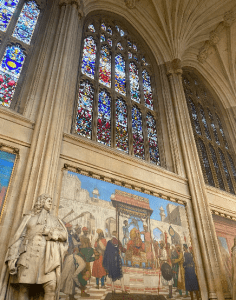While walking from the starting security line to inside the Parliament building, there were many sights to see. On one side was a statue of Oliver Cromwell, and further down the path was a clear view of Big Ben. This building is essential for the government as legislation is created and modified here. The Parliament has three main parts: the Crown, the House of Commons, and the House of Lords. On our tour of Parliament, we explored the House of Lords and saw their room’s layout. The House of Lords and the House of Commons are color-coordinated to distinguish between the two chambers. The House of Lords has a red color scheme, while the House of Commons’ green color scheme is also distinctive. As such, the House of Lords’ chamber is decorated with red benches and upholstery, and the walls have a variety of red hues. This intentional design serves as a way to identify between the two branches of the UK’s legislative process.
As we came through one of the main halls, each side was covered in paintings representing Britain’s history. The tour guide proceeded to discuss a few details of each artwork and its significance. One in particular that stood out was the piece that depicted Indians during the time of the East India Company. The painting portrays some version of a treaty or agreement between the two involved parties. The Crown granted the East India Company rights to create trade routes. As a result, the East India Company made its way to India, which led to them enforcing their power and Britain colonizing India.
Things have changed since this time in history, and more recently, Britain has had a first by electing Rishi Sunak as Prime Minister. Sunak became the prime minister in October 2022, and he is the first British prime minister of Indian origin. The idea of someone like Sunak coming to power would not have been seen or expected during a time like the colonial era. This leadership would have been unfathomable because Indians were subject to the rules and endured suffering. Due to the crown’s power in India, many Indians underwent discrimination and violence. Even Sunak’s ancestors and others during that time faced discrimination. His grandfather, Ramdas Sunak, migrated to Nairobi as someone who managed the export and employer needs and the Indian laborers. Since he was not classified as an indentured laborer, there were not as many restrictions, and therefore could move back and forth. It was seen that many had class divisions, and the educated emigrants typically separated themselves from the poorer emigrants. However, many faced racism, and Indians faced inequalities.
Being of South Asian descent and the first non-white prime minister of the United Kingdom, Rishi Sunak marks a crucial turning point in the nation’s political history. However, it is essential to recognize those in parliament who came before him and laid that foundation. Dadabhai Naoroji was the first Asian member of the House of Commons in 1892. He was a trailblazer during his time advocating for progressive issues, such as gender equality and wealth disparities. He had anti-racist and anti-imperialist beliefs and even stated that Britain was “bleeding India to death.” Ultimately, he believed perseverance and determination were essential.


